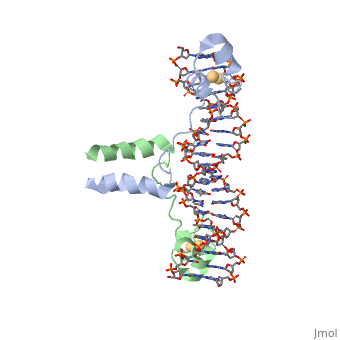While DNA contains all the genetic material in a cell, proteins play an important role in regulating the transcription of DNA to RNA, not to mention replication, repair and packaging.. The interactions between DNA and proteins are important in this process. Most sequence specific interactions occur in the , as the in this groove. In contrast, the contains more of the of DNA.
Helix-Turn-Helix Interactions with DNA
The first DNA binding domain characterized was the helix-turn-helix. In a such as the Cro repressor, two α helices are joined by a turn; there may be additional supporting structures, such as additional helices or beta strands, but this is the basic motif. In most cases, the contributes most to DNA recognition, and hence it is often called the "recognition helix". It binds to the major groove of DNA through a series of hydrogen bonds and various Van der Waals interactions with exposed bases. For example, forms hydrogen bonds with both A219 and A220 of the DNA strand. There are also ionic interactions between basic protein residues, such as , with the backbone phosphate groups. The N-terminal alpha helix stabilizes the interaction between the interaction between protein and DNA, but does not play a particularly strong role in its recognition.[2] The recognition helix and its preceding helix always have the same relative orientation.[
Leucine zippers
The Basic Leucine Zipper Domain () is found in many DNA binding eukaryotic proteins, especially transcription factors such as the cAMP Responsive Element Binding (CREB) protein . One part of the domain contains a region that mediates sequence specific DNA binding properties via such as arginine and lysine. These basic residues can either interact ionically with the or via with the bases.
Since these basic amino acids would usually repel, the allows for dimerization of the protein. Notice the spacing of the leucine residues; they are spaced by 3, 4, or 7 amino acids, causing them to be on the same face of the alpha helix. this hydrophobic set of "zipper teeth" allows this region to interact with another monomer unit, pairing with the exact same residues to form a , shown in grey. At the base of the leucine zipper, where the protein meets the DNA, is positioned a . While you would expect a divalent cation to be surrounded by negatively charged amino acids from the protein or backbone phosphates from the DNA, its inner chelation sphere is completely composed of . The next sphere of interactions include (one from each protein chain)
Zinc fingers
is a transcription factor that induces genes required for the metabolism of galactose, specifically enzymes involved in the conversion of galactose to glucose, and is an example of a zinc finger DNA binding protein. The protein binds as a to a symmetrical 17-base-pair sequence. Each subunit folds into three distinct modules: a compact, (residues 8-40), an extended (41-49), and an (50-64). The small, , which contains two metal ions tetrahedrally coordinated by six cysteines. This metal binding domain recognizes a conserved at each end of the site through direct contacts with the , including hydrogen bonding between a . A short coiled-coil dimerization element imposes 2-fold symmetry. A segment of extended polypeptide chain links the metal-binding module to the dimerization element and specifies the length of the site. The relatively open structure of the complex would allow another protein to bind coordinately with GAL4.

